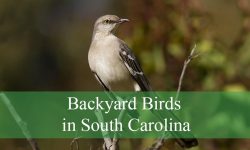All types of striped caterpillars are larvae of vibrant moths and butterflies. These crawling insects are the easiest to notice and identify on earth. You can find them munching on the leaves in the garden, park, and woodland.
Identifying the exact name of a striped caterpillar can be a daunting experience for gardeners. We wrote this identification guide to help in knowing the exact name of a striped garden caterpillar based on the pictures and descriptions.
Are Striped Caterpillars Poisonous?
Striped caterpillars are harmless and won’t sting. Most of these caterpillar species are hairlessly making them safe to handle without wearing protective gloves.
But the fuzzy striped caterpillars are dangerous to handle since the irritating hairs contain toxins that cause nasty rashes and swellings after breaking into the skin.
Some striped caterpillars belong to the furry caterpillar category due to different genus classifications. Refrain from handling any caterpillar species without protective gloves.
Different Types of Striped Caterpillars
Most striped caterpillars look alike at the first glance. But these caterpillars have unique attributes that make it possible to identify them. Here is a list of 37 types of striped caterpillars with their pictures and descriptions:
Redhumped Caterpillar
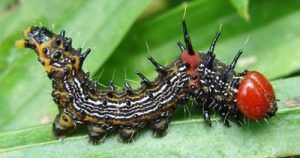
A red-humped caterpillar is a yellowish moth larva with lateral black, white, and yellow stripes running lengthwise along its body.
Other distinctive features are the short black fleshy spines, bulbous red head, and reddish bump behind the head.
These caterpillars have a maximum length of 38mm and hail from North America. They love munching leaves of woody plants in the spring.
Scientific Name |
Schizura concinna |
Host Plants |
Apple, almond, cherry, cottonwood, birch, and willow trees |
Identification Features |
Yellow body with lateral black and white stripes, a red hump behind the head, and a red bulbous head. |
Catalpa Sphinx Caterpillar
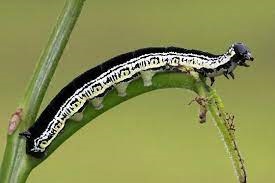
It is a vibrant black caterpillar with yellow stripes along its body. The larva is also called the Catawba worm due to its hairless body.
The long worm-like insect turns jet-black with a neon yellow band along the sides when approaching the pupation phase. These caterpillars can grow up to 50mm long.
These slender black caterpillars keep changing their colors throughout their different growth stages. Juvenile species are greenish-yellow with a black stripe down the back.
Scientific Name |
Ceratomia catalpae |
Host Plants |
Catalpa species |
Identification Features |
Jet-black body with bright yellow stripes along the sides. |
Common Buckeye Caterpillar
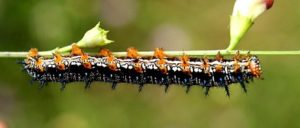
It is a spiky black caterpillar native to Arizona and other desert states in the US. These crawling insects thrive in a hot and dry climate.
These butterfly caterpillars have black bodies with orange-brown or white stripes running down their back. The reddish-orange head is the distinctive feature.
Common buckeye caterpillars can grow up to 40mm long. The branched spines can cause skin irritation and nasty rashes when handled without gloves.
Scientific Name |
Junonia coenia |
Host Plants |
Plantains, monkey flowers, and false foxglove |
Identification Features |
Black branched spines and orange-brown stripes. |
Old World Swallowtail Caterpillar
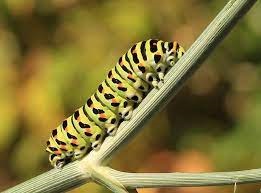
It is a butterfly caterpillar with a lime-green body, orange-brown spots, and black stripes wrapping around each segment. These caterpillars can grow up to 45mm long.
These plump green caterpillars also have a line of black dots along the abdomen base and a few yellow spots on the head for easy identification.
The old-world swallowtail caterpillars raise their bodies to produce projections behind the head and release a foul smell when threatened.
Scientific Name |
Papilio machaon |
Host Plants |
Sagebrushes |
Identification Features |
Lime-green body with black and orange bands on each segment. |
Eight-Spotted Forester Caterpillar
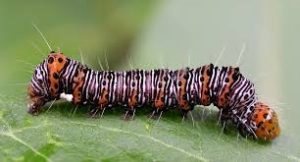
It is a bright orange caterpillar with thin white and black bands traversing each segment for easy identification. The small black pointed fleshy bumps are the distinctive features.
The wispy white hairs sticking out of the body are noticeable with a close look. These caterpillars can grow up to 33mm long before undergoing pupation.
These orange and black striped caterpillars are native to the Eastern part of North America due to the presence of Virginia creeper plants.
Scientific Name |
Alypia octomaculata |
Host Plants |
Virginia creeper plants |
Identification Features |
Orange body with white and black stripes along with black dots. |
Yellow-necked Caterpillar
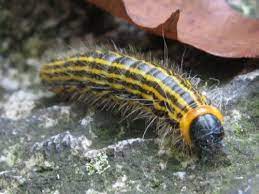
It is a vibrant black caterpillar with yellow stripes and a yellow neck. The black head and conspicuous orange-yellow collar-like growth are the distinctive features.
Other additional features are the long wispy hairs covering the cylindrical body to give the larva a fuzzy appearance. These caterpillars can grow up to 50mm long.
These large black and yellow striped caterpillars usually curl their heads back for defense when threatened. Refrain from handling them to avoid skin irritation.
Scientific Name |
Datana ministra |
Host Plants |
Oaks and birches |
Identification Features |
Yellow stripes running from head to tail on the shiny black body |
Box Tree Moth Caterpillar
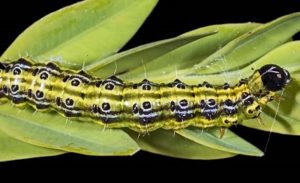
It is a green-striped caterpillar with black and yellow bands running from the head to the tail. The distinctive traits are the round black head, fine white spines, and black bumps.
These boxwood tree moth caterpillars can grow up to 40mm long. These stripy crawling insects can defoliate the boxwood shrub if not controlled.
Scientific Name |
Cydalima perspectalis |
Host Plants |
Boxwood species |
Identification Features |
Green body with black stripes and small black fleshy bumps producing fine setae. |
Yellow-Tail Moth Caterpillar
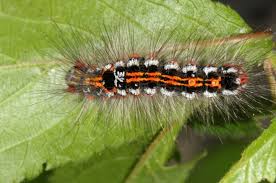
It is an orange and black striped caterpillar with a body covered in tufts of long fine hairs for easy identification. The vibrant striped caterpillar also has white spots along its sides.
The reddish-orange bands on the black body and reddish bumps on the head are other distinctive features. Refrain from touching these caterpillars to avoid skin irritation.
These caterpillars love feeding on the leaves of oaks, birches, rowan, and alder trees. It has an average growth length of 30mm.
Scientific Name |
Sphrageidus similis or Euproctis similis |
Host Plants |
Oak, hawthorn, and blackthorn |
Identification Features |
Hairy black caterpillar with an orange band along the back and orange markings on both ends. |
Hieroglyphic Moth Caterpillar
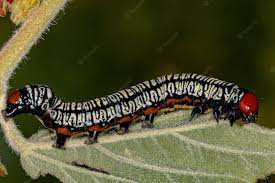
The moth caterpillar has zebra patterns that make it unique from other striped caterpillars. The slug-like caterpillar has bands of black and white markings on its body.
Other distinctive features are the redhead and white and black legs. These crawling insects are native to Florida and feed on sweet potatoes, soybeans, and pecan crops.
The moth caterpillar has an average growth length of 45mm long. Use chemical treatments to control the population of these striped garden caterpillars.
Scientific Name |
Diphthera festiva |
Host Plants |
Soybeans, Sweet Potatoes, and Pecans |
Identification Features |
A white caterpillar with black stripes that resemble zebra patterns. |
Pink-Spotted Hawkmoth Caterpillar
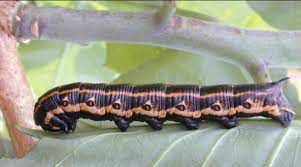
It is the largest black or dark brown caterpillar with orange-brown stripes and conspicuous eyespot markings along the sides.
The broad pale creamy-pink band and two thin darker orange-pink bands are the distinctive features. These larvae often defoliate the leaves of sweet potatoes in the garden.
Scientific Name |
Agrius cingulata |
Host Plants |
Sweet potato and jimsonweed plants |
Identification Features |
Smooth dark brown body with pinkish or orange markings along its sides. |
Banded Sphinx Caterpillar
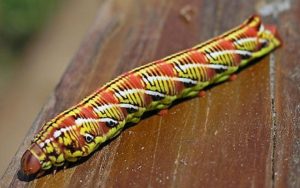
It is a large cylindrical-shaped moth caterpillar with a green body and slanted yellow stripes on its sides. The slug-like and diagonal white lines are the distinctive features.
The green-striped caterpillar can grow up 70mm long. The moth larva keeps changing colors as it approaches the pupation phase.
Scientific Name |
Eumorpha fasciatus |
Host Plants |
Evening primrose, grapes, fuchsia |
Identification Features |
Tube-shaped striped caterpillar with green and black stripes or red with yellow stripes. |
Dragon-Headed Caterpillar
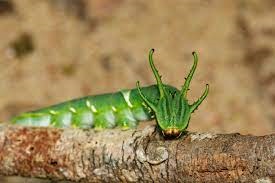
It is a green caterpillar type having yellow-green stripes along its sides and four curved fleshy projections on the flat head.
The dragon–headed caterpillar usually darkens when it approaches the pupation. It has a maximum length of 30mm and feeds on the foliage of various plants.
Scientific Name |
Polyura athamas |
Host Plants |
Poplar, ash, willow, apple, and other deciduous trees. |
Identification Features |
Flat head with four curved fleshy projections and yellow or green diagonal stripes along the sides. |
Hackberry Emperor Caterpillar
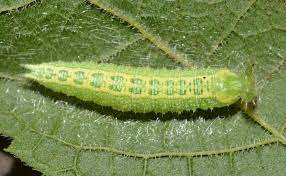
It is a butterfly caterpillar with a slug-like appearance. The crawling insect has two thin yellow stripes running lengthwise on the pale-green body.
The forked tail is the distinctive feature for easy identification. The hackberry emperor caterpillar can grow up to 40mm long.
The flattened translucent green head and tiny yellow bumps covering the pale-green body make it challenging to spot these caterpillars on the leaves.
Scientific Name |
Asterocampa celtis |
Host Plants |
Hackberry trees |
Identification Features |
Green body with yellow bands and split tail |
Honey Locust Moth Caterpillar
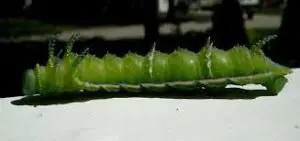
It is a unique green-striped caterpillar marked with red horn projections on the head and the tail. The white spots and pointed fleshy spines are the distinctive features.
The red and white bands running along the abdomen sides are the additional distinctive features for easy identification. The larva can grow up to 38mm long.
The stout green caterpillar keeps changing color throughout its growth stages. We recommend not handling these caterpillars without wearing protective gloves.
Scientific Name |
Syssphinx bicolor |
Host Plants |
Kentucky coffee trees and Honey locust trees |
Identification Features |
Green body with white and red lateral stripe. Reddish horns and white spots are distinctive features. |
Orange-Barred Sulphur Caterpillar
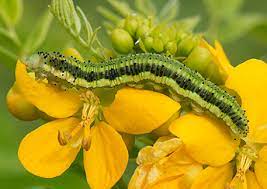
It is a green caterpillar with yellow and black stripes running from the head to the tail. It also has yellow prolegs and dark green heads for easy identification.
The slug-like caterpillar turns yellow with black bands traversing each segment before the pupation period. These caterpillars are native to North America.
Scientific Name |
Phoebis philea |
Host Plants |
Peas |
Identification Features |
Yellowish-green body with yellow lateral stripe and covered in dark bluish and fleshy bumps. |
Stinging Rose Caterpillar
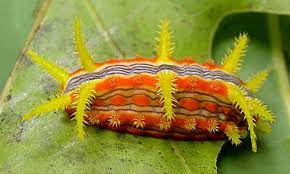
It is a venomous striped caterpillar often seen in New York, Florida, and East Texas. It has a purple-striped band running along its back and jagged spiny projections.
The flattened dark orange or vivid yellow body is the distinctive feature for easy classification and identification. The moth caterpillar can grow up to 25mm long.
The venomous spines can cause skin irritation and nasty stings when handled without wearing protective gloves.
Scientific Name |
Parasa indetermina |
Host Plants |
Apple, dogwood, hickory, oak, poplar, and rose trees. |
Identification Features |
Yellow or orange-colored caterpillar with a band of the purple stripe along its back. |
Giant Woolly Bear Caterpillar
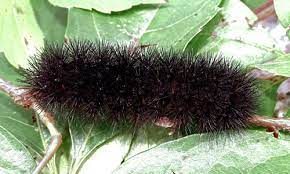
It is a spiky black caterpillar with red bands separating each segment. This black fuzzy caterpillar usually curls to defend itself from potential predators.
The sharp black spines can cause skin irritation and painful stings when handled without protective gloves. The furry red-striped caterpillar can grow up to 75mm long.
These black furry caterpillars love feeding on the leaves of citrus, cabbages, willow, and sunflowers. These larvae are poisonous to birds and other predators.
Scientific Name |
Hypercompe scribonia |
Host Plants |
Citrus trees, cabbages, willow trees, and sunflowers. |
Identification Features |
Black body covered in black spines with bright red bands around each segment |
Tobacco Hornworm Caterpillar
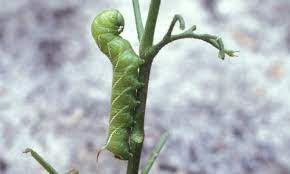
It is a large green caterpillar with diagonal white stripes along its sides. The plump lime-green caterpillar has a conspicuous pinkish-horned tail.
The white-ringed dark eyespot on the sides is a distinctive feature for easy recognition. The caterpillar can grow up to 100mm long.
These striped green caterpillars are harmless and safe to handle. But their voracious appetite makes them destructive.
Scientific Name |
Manduca sexta |
Host Plants |
Tobacco, tomato, pepper, eggplant, and various weeds |
Identification Features |
A green caterpillar with a large downward-turned head and slopping white stripes along its sides. |
White-Marked Tussock Caterpillar
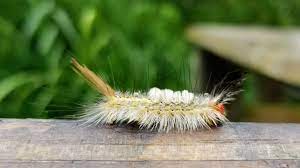
It is a hairy caterpillar with black and yellow stripes running from the head to the tail for easy recognition. The four creamy white toothbrush-like bristle tufts and long whisker-like spines are the distinctive features.
Bright red dots on the back and black pencil hairs at the hind end are other distinctive features for easy recognition. These crawling insects can grow up to 35mm long and the fine hairs can cause skin irritation.
Scientific Name |
Orgyia leucostigma |
Host Plants |
Apple, basswood, elm, maple, oak, pear, plums, poplars, redbud, rose, sycamore, walnut, and willow |
Identification Features |
Black and yellow striped body with four toothbrush-like creamy white tufts. The red defensive glands and long pencil hairs are the prominent features. |
Pink-Striped Oakworm Moth Caterpillar
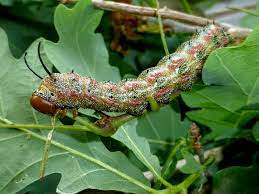
It is a dark-colored moth caterpillar with white spots and pink stripes. The small fleshy projections and flat olive face are the distinctive features.
Other distinctive features are a pair of antennae-like horns and four pairs of black prolegs. These caterpillars can grow up to 50mm long in a cylindrical shape.
These crawling insects have a voracious appetite and can defoliate plants. They mainly feed on the leaves of oaks, birches, maples, and hazel trees.
Scientific Name |
Anisota virginiensis |
Host Plants |
Oaks, birches, maples, and hazel trees. |
Identification Features |
Dark brownish and pink stripes run lengthwise on the body. The tiny white speckles are conspicuous. |
Rosy Maple Caterpillar
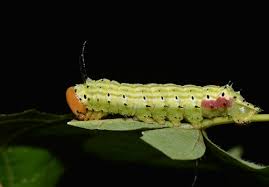
It is a sizeable plump caterpillar with light green and white stripes. The striped markings make these crawling insects resemble hardboiled candies.
Rosy maple caterpillar has broad white stripes on the back with thin ones and wider green stripes on the sides. The small black dots on each segment are conspicuous.
The reddish head and red markings on the tail are other distinctive features. The two black horns on the head and small black spines make them scary.
Scientific Name |
Dryocampa rubicunda |
Host Plants |
|
Identification Features |
Light green with pale yellowish-green stripes along its body. |
Gulf Fritillary Caterpillar

It is a vibrant spiky striped caterpillar native to Texas and Florida. The jaggy-looking caterpillar has spines sticking out on its back and sides.
The brightly colored caterpillar has a dark-brown or gray back and orange or yellow stripes on either side. A single white stripe runs along the sides for easy recognition.
These crawling insects love feeding on the leaves of passiflora plants and later transform into spectacular butterflies after pupation.
Scientific Name |
Agraulis vanillae |
Host Plants |
Passiflora plants |
Identification Features |
Lateral dark brown-gray, orange, and white stripes. Jaggy-looking black spines are the distinctive features. |
Cross-Striped Cabbageworm
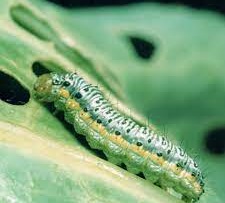
It is a striped worm-like caterpillar with a green body, prolegs, and head. The yellow stripes running on the sides and rows of black and green dots are distinctive features.
The fine spines sticking out on the back can cause skin irritation. These pesky insects defoliate crops, trees, and ornamental shrubs.
Scientific Name |
Evergestis rimosalis |
Host Plants |
Kales, cabbages, broccoli, and other edible crops |
Identification Features |
Light brown oval head and a green body with lateral stripes and spot markings. |
Angus Datana Moth Caterpillar
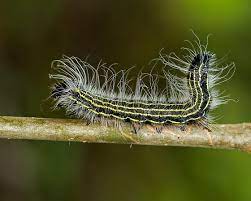
These crawling insects are native to North America. Angus datana moth caterpillars belong to the striped furry caterpillar category.
The long spindly spines around the body are the distinctive features for easy classification and differentiation from woolly bear caterpillars.
Scientific Name |
Datana angusii |
Host Plants |
|
Identification Features |
The black and yellow stripes run lengthwise on its body. The whitish-gray wispy hairs grow in clusters on each segment. |
American Painted Lady Caterpillar
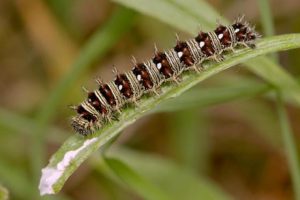
It is a stripy black fuzzy caterpillar with several horn spikes along the sides. The crawling insect has whitish or pale yellow bands on the dark brown body.
The dorsal stripes separating the segments are the distinctive features though they create a scary-looking appearance.
The branched spines cause skin irritation and painful sting when handled without wearing protective gloves. Red and white dots are noticeable between the white stripes.
Scientific Name |
Vanessa virginiensis |
Host Plants |
Spoonleaf cudweed |
Identification Features |
Jaggy-looking spines sticking out from the back and sides. White bands are more conspicuous. |
Zebra Caterpillar
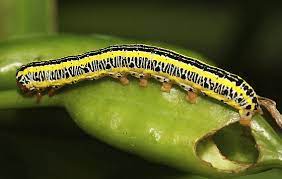
It is a caterpillar with black and white stripes wrapping around each segment. The yellow stripes running lengthwise along the body are conspicuous.
Zebra caterpillars munch the leaves of cabbages, kales, and other low-growing crops in the garden. The crawling insect keeps changing color throughout its growth phase.
Scientific Name |
Melanchra picta |
Host Plants |
Cabbages and kales |
Identification Features |
Vibrant black, yellow, and white stripes with a reddish-brown oval heads. |
Azalea Caterpillar
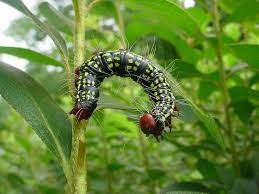
It is a strange-looking caterpillar with an orange globular head and green striped body for easy identification. These caterpillars feed in clusters and can destroy your trees.
The broad black stripes and thinner green stripes are the distinctive features. Other prominent features are the rusty brown or orange head and small brownish tail.
These caterpillars are harmless to handle but they can cause havoc in your garden by munching the leaves of trees, shrubs, and crops.
Scientific Name |
Datana major |
Host Plants |
Blueberry, apple, and oak |
Identification Features |
Orange globular head with a stripy green and black body. |
Angle Shades Moth Caterpillar
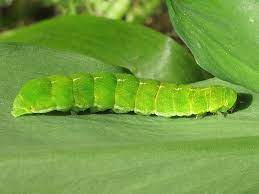
It is a lime-green larva with a conspicuous pale stripe on each side. The faint yellow dorsal lines separate the segments.
The caterpillar is hairless and harmless to humans. These crawling insects munch the leaves of oaks, birches, bramble, and barberry plants.
Scientific Name |
Phlogophora meticulosa |
Host Plants |
Common nettle, hop, birches, oak, barberry, and bramble |
Identification Features |
A single white-yellow stripe along its sides |
White-lined Sphinx Caterpillar
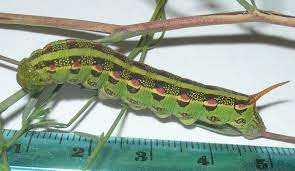
It is a green caterpillar with a line of white lines running along the abdomen sides. You can also spot orange or brown dots running in lines down its body.
The lime-green caterpillar also has a black-tipped orange or yellow horn at the tail. The moth larva is harmless despite the spiky horn on its tail.
Scientific Name |
Hyles lineata |
Host Plants |
Apple trees and evening primrose plants |
Identification Features |
Brown Hooded Owlet Striped Caterpillar
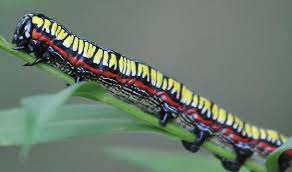
It is a black-striped caterpillar with a stump at one end. The faint white markings that run from the head to the head are distinctive features.
The yellow stripes along the sides and red dots are the additional features for easy identification and classification.
These brown hooded owlet-striped caterpillars feed on asters and goldenrods. They turn into large gray moths after pupation.
Scientific Name |
Cucullia convexipennis |
Host Plants |
Asters and goldenrods |
Identification Features |
Colorful moth caterpillar with yellow, black, white, and red colors. |
Queen Caterpillar
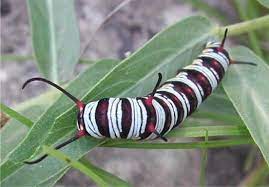
It is a butterfly caterpillar that resembles the monarch larva. The white body with black stripes and yellow markings are the distinctive features.
The thin black stripes and broad black ones are the features that make the queen caterpillar unique from its monarch counterparts.
Queen caterpillars are native to Texas and Florida. You can also spot other species in Mexico and Central America with yellow, blue, green, and dark brown stripes.
Scientific Name |
Danaus gilippus |
Host Plants |
Milkweed plants |
Identification Features |
Large fat hairless larva with several black and white stripes along with yellow patches |
Giant Sphinx Caterpillar
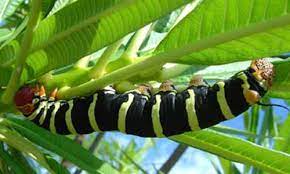
It is a large striped caterpillar with an average size of 15cm long. The fat black body with yellow bands around each segment is the distinctive feature.
The stinging striped caterpillar also has an orange-brown head and a protruding spike on the tail. Other distinctive features are the four pairs of red-orange prolegs.
The fine hairs covering the moth caterpillar cause skin irritation and itchy bumps when handled without protective gloves.
Scientific Name |
Pseudosphinx tetrio |
Host Plants |
Frangipani or allamanda |
Identification Features |
Fat black caterpillar with yellow bands around each segment |
Striped Garden Caterpillar
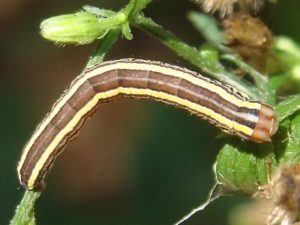
It is a long brown worm-like insect with light stripes running lengthwise along its body for easy classification. These garden pests defoliate your crops and ornamental trees.
The yellow-white stripes are the distinctive features along with their globular brown head. These crawling creatures feed on cherry, raspberry, mustard, and milkweed plants.
Scientific Name |
Trichordestra legitima |
Host Plants |
Cherry, raspberry, mustard, and milkweed plants |
Identification Features |
Bright stripes of brown and yellow run from head to tail. |
Cinnabar Moth Caterpillar
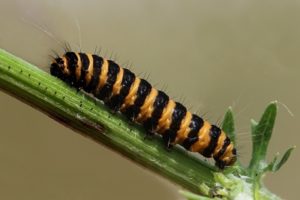
It is a moth larva with wispy spines emanating from the orange and black striped body for easy identification. These caterpillars feed on the leaves of crops, trees, and shrubs.
The vibrant black and orange caterpillar has long thin gray hairs and can grow up to 3cm long. The black bands wrap around the orange or yellow body.
Scientific Name |
Tyria jacobaeae |
Host Plants |
Ragwort plants |
Identification Features |
Black and yellow or orange bands on each segment |
Orange Striped Oakworm Caterpillar
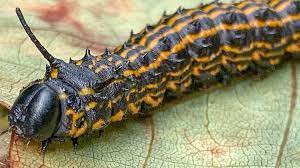
The worm-like caterpillar has a series of orange stripes running from the head to the tail for easy identification. These horned caterpillars are harmless and safe to handle.
The black and orange stripes are distinctive features. Orange-striped oakworm can grow up to 5cm long and feeds on the leaves of oak trees.
These crawling insects may also have pink or yellow stripes. They turn into vibrant yellow, pink, and orange-colored moths after pupation.
Scientific Name |
Anisota senatoria |
Host Plants |
Oaktree leaves |
Identification Features |
Striped orange caterpillar with prominent black horns on its head and slightly spiky black. |
Black Swallowtail Caterpillar
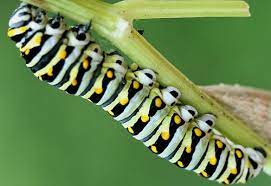
It is a plump green caterpillar that resembles the monarch butterfly larva. But each green segment has a black stripe and yellow markings for easy recognition.
The four pairs of prolegs have black dots to make these crawling insects stand out from their monarch counterparts. They release foul smells when threatened by predators.
These types of striped green caterpillars munch the leaves of carrots, dill, parsley, and other garden crops. They are considered real garden pests.
Scientific Name |
Papilio polyxenes |
Host Plants |
Carrots, dill, parsley, and garden herbs |
Identification Features |
Ugly striped caterpillar with bands of black, white, and yellow on each segment. |
Monarch Butterfly Caterpillar
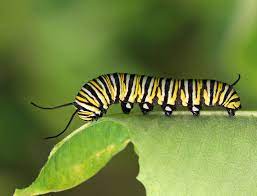
It is a striped butterfly caterpillar that feeds on milkweed plants. Monarch butterfly caterpillars are also called common tigers, wanderers, or milkweed larvae.
These crawling insects have bands of black, white, and yellow around their segments for easy identification. The pairs of horns at either end are distinctive features.
Monarch butterfly caterpillars are harmless and won’t sting. The white dots around the prolegs and stumpy feet at the middle segments are additional distinctive features.
These butterfly larvae have a maximum length of 5cm. They are safe to handle since they are non-poisonous and do not sting or bite.
Scientific Name |
Danaus plexippus |
Host Plants |
Milkweed plants |
Identification Features |
Long fat larva with yellow, white, and black bands around its body. |
People Who Read This Also Read:



